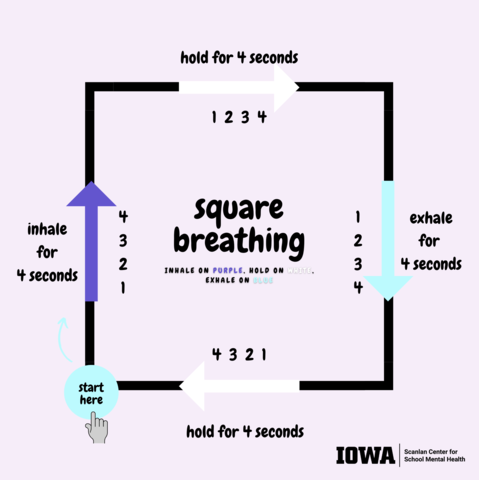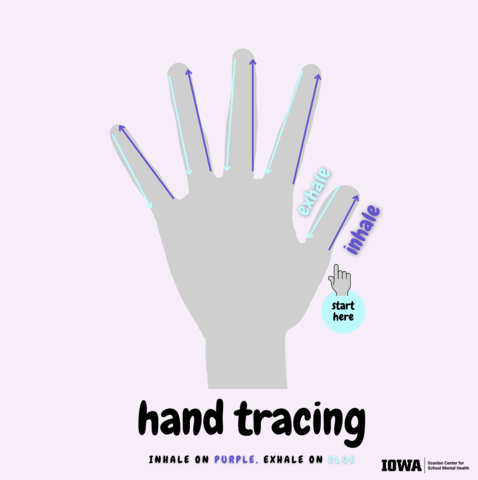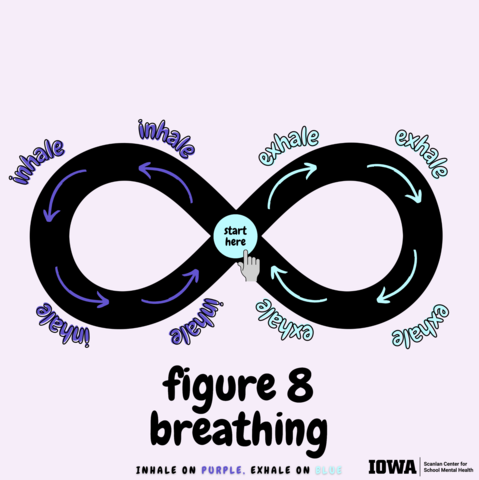Mindfulness.
A fancy word that gets thrown around quite regularly nowadays. A word that may stir up some pleasant or unpleasant emotions.
A word that can bring up a surplus of questions like…
“What does mindfulness really mean?!?”
“How do we actually practice mindfulness?”
And as teachers… “How are we supposed to incorporate it into our classroom on top of everything else we need to do?!?”
I have often wondered about these exact same questions (you’re not alone!).
After growing up in a family of teachers, I can understand (and appreciate) the everyday hustle and bustle of the classroom.
I can also understand that it can be hard to take extra time out of the day to learn something new to teach your students.
We hear you.
We support you.
We want to make mindfulness in the classroom seem a little more doable. So, in the following post, I invite you to learn…
- what mindfulness is,
- the benefits that come with it,
- ways to practice it
- and how to easily implement it into your classroom TODAY!
What is it?
Mindfulness can be described as a practice that allows us to be intentionally and nonjudgmentally present in the current moment.
Although this may sound simple, it can be pretty difficult, right?!
Throughout the day your mind is being pulled in a hundred different directions all while managing a classroom full of students, getting through your lesson plans, and figuring out your next bathroom break.
It is normal to experience distractions or mind-wandering when practicing mindfulness; as showcased above, we’re busy people!
Allow yourself to simply notice these distractions and/or mind-wandering when being mindful and gently bring yourself back to the moment.
It is also normal to have judgments when practicing mindfulness. Allow yourself to acknowledge the judgments and work to let them float away, like a cloud in the sky.
In a way, mindfulness is like reading. In order to get better at it, we must practice it! Mindfulness invites us to practice being in the here-and-now.
There are many different ways to practice mindfulness, and it doesn’t always have to look like sitting in silence for 15 minutes (although that does sound nice 😊).
What are the benefits?
Research has proven many different benefits of practicing mindfulness including:
- lower levels of anxiety, stress, and depression, (Lyons & DeLange, 2016)
- improve emotion-regulation, working memory, and self-esteem, (Lyons & DeLange, 2016)
- and enhance the body and mind connection. (Ogden & Goldstein, 2017)
Research also shows that mindfulness in schools:
- allows students to be better equipped to learn, (Lyons & DeLange, 2016)
- is an ideal intervention for improving self-regulation (which can be a predictor of school success), (Lyons & DeLange, 2016)
- and regulates the classroom atmosphere. (D’Alessandro et al., 2022)
Who can practice it?
Mindfulness is for anyone and everyone!
Your personal mindfulness journey —
Not only is it important for your students to practice mindfulness, it is also important for you, the educator, to practice it. It will be beneficial for your well-being, AND it can positively affect your mindfulness-leading capabilities in the classroom.
Try out some of the mindfulness activities below, like figure 8 breathing, progressive muscle relaxation, and mindful journaling. Or check out this resource for other adult mindfulness activities.
Your students’ mindfulness journey —
Practicing mindfulness during the day at school can indeed help your students. But it is also important to encourage your students to practice mindfulness outside the classroom!
How to implement it in the classroom?
We now know what mindfulness is and the benefits of practicing it. How do we bring it into the classroom?
First things first. Make sure to set aside time to fully explain mindfulness to your students.
After students are up-to-speed as to what mindfulness is, you can start sprinkling mindfulness into the classroom.
Try turning ordinary tasks into mindfulness activities by simply drawing attention to the present moment, the breath, and the task at hand.
(For example, when students are transitioning from subject to subject (or class to class), prompt them to notice how their feet feel against the floor, what sound their shoes may be making, etc.)
Once your students have warmed up to the idea of mindfulness, try adding more structured mindfulness activities into your classroom. Here are some best practices:
- Before facilitating a mindfulness activity in your classroom, practice it yourself to become familiar and comfortable with it.
- Weave in 1 or 2 short mindfulness activities throughout the day. These can be planned or unplanned and based on the students’ needs. Start small and then increase the length and complexity of activities as students get the hang of it.
- Remind students the purpose of mindfulness and of the current activity before jumping into it.
- You are encouraged to be an active facilitator and role model – practice the mindfulness activity alongside your students.
- Encourage students to share their experiences after completing a mindfulness activity. This allows individuals to learn from others and connect with their own thoughts and feelings.
- Put your own spin on it! Customize and innovate based on your students’ preferences and abilities.
- You may feel some resistance to mindfulness at first…and your students may also feel this way. Use this discomfort to gently challenge yourself and your students to try something new or different.
- Remember to “use it or lose it”. Practice, practice, practice!
Classroom Mindfulness Activities
Congrats! Now you are ready to start implementing mindfulness in your classroom. As promised, here are 8 mindfulness activities separated by grade level for you to try.
Kindergarten, 1st, and 2nd Grade
Pinwheel Breathing
Purpose: To focus and bring attention to the breath; Understand how different types of breath can affect our bodies and minds.
Length of Time: 2-5 minutes
Materials: Pinwheels (see below)
- Explain the purpose of this exercise.
- Explain/remind participants to use belly breathing (diaphragmatic breathing) when completing the activity.
- Find a comfortable seated position.
- Give participants a pinwheel and guide them through a series of different types of breaths:
a. Normal breaths: breathe on the pinwheel using a ‘normal breath’
- What does the pinwheel do?
- How does your body and mind feel?
b. Short, quick breaths: breathe on the pinwheel using ‘short, quick breaths’
- What does the pinwheel do now?
- How does your body and mind feel?
- Does your heartbeat feel slow or fast?
c. Long, deep breaths: breathe on the pinwheel using ‘long, deep breaths’
- What does the pinwheel do now?
- How does your body and mind feel?
- Do you feel relaxed? Do you feel calm?
- Is your heart beating slow or fast?
5. After experimenting with different breaths, encourage participants to discuss their findings. Connect the different types of breathing to different situations they may encounter and how their breath can help them.
Adapted from: https://www.nytimes.com/article/how-to-meditate.html
****(make your own pinwheel : How to make a spinning paper Pinwheel DIY, paper windmill craft,)
5 Senses Scavenger Hunt
Purpose: To bring focus and attention to the 5 senses and the surrounding environment to become grounded in the present moment.
Length of Time: 2-5 minutes
Materials Needed: (Optional) A piece of candy or fruit snacks.
- Explain the purpose of this activity.
- Explain that everyone will be using their 5 senses to go on a “scavenger hunt” around the room.
- Go over what the five senses are and set up the rules of the activity (hands to self and only pointing at things they find around the room).
- Complete the hunt by going through the following senses:
- Smell: Find one thing around the room that you enjoy the smell of.
- Touch: Find one thing around the room that you enjoy touching.
- Look: Find one thing around the room that you can see that catches your attention.
- Listen: Find one thing around the room that makes a noise you can hear.
- (Optional) Taste: Give participants a piece of candy or fruit snack to engage the sense of taste.
5. End the activity by asking the participants to reflect on their experience with one another.
Adapted from: https://www.healthline.com/health/mind-body/mindfulness-activities#for-kids
3rd, 4th, and 5th Grade
Square Breathing
Purpose: To draw attention to the breath and slow heart rate down
Length of Time: 2-5 minutes
Materials Needed: (optional) Square breathing handout
- Explain the purpose of the activity.
- Explain/remind participants to use belly breathing (diaphragmatic breathing) when completing the activity.
- Instruct participants to find a comfortable seated position.
- Explain how to complete the activity:
- Imagine a square and find one corner of the square.
- Trace your finger along the side of the square to the next corner while breathing in for 4 seconds.
- Trace your finger along the side of the square to the next corner while holding your breath for 4 seconds.
- Trace your finger along the side of the square to the next corner while breathing out for 4 seconds.
- Trace your finger along the side of the square to the next corner while holding your breath for 4 seconds.
- Return to step b. and repeat.
5. Allow participants to practice square breathing for 2-5 minutes.
6. Encourage participants to reflect on their experiences and share with one another.

Progressive Muscle Relaxation with Animals
Purpose: Bring attention to the breath and body through progressive muscle relaxation (PMR). PMR aids in calming the “fight or flight” response in the body.
Length of time: 5-10 minutes
Materials Needed: None
- Explain the purpose of the activity.
- Explain/remind participants to use belly breathing (diaphragmatic breathing) when completing the activity.
- Encourage participants to spread out throughout the room to ensure they have space to engage in the activity.
- Guide participants through the following script: (feel free to customize the script to make it your own)
- Feet: “Let’s begin by pretending we are standing in a pile of mud. Squish your toes together while squishing the mud (for a couple of seconds). Now relax your feet.” (Repeat)
- Legs: “Pretend now that you are hiding from an elephant. You need to squat down so that the elephant doesn’t see you. Squat low (hold for a couple of seconds). You can stand back up; the elephant left. Oops, here he come’s again.” (Repeat)
- Stomach: “Now you are laying down on the beach and a bird almost lands on you. Scrunch up your tummy so it doesn’t land on you! (Hold for a couple of seconds). The bird is gone so you can relax now.” (Repeat)
- Hands: “Pretend you have 2 lemons in your hands. Squeeze the lemons as hard as you can so we can make lemonade (for a couple of seconds). Now drop the lemons and relax your hands.” (Repeat)
- Arms: “Let’s pretend now that we are a cat, and we are laying in the sun. Stretch your arms above your head like a cat (for a couple of seconds). And relax.” (Repeat)
- Shoulders: “Now there is a fly buzzing around your head, and you scrunch your shoulders up to shoo the fly (for a couple of seconds). Now relax.” (Repeat)
- Face: “Now the fly is about to land on your nose! Scrunch up your face to shoo the fly away (for a couple of seconds). The fly is gone so you can relax. She’s coming back…” (Repeat)
5. At the end of the activity, encourage participants to reflect on their experience and share with everyone.
6th, 7th, and 8th Grade
Mindful Journaling
Purpose: Spend time reflecting, being mindful, and being present in the current moment.
Length of Time: 3-10 minutes
Materials Needed: Paper and a writing utensil
- Explain the purpose of the activity.
- Instruct participants to get a piece of paper and a writing utensil out for use.
- Read each writing prompt out loud (or display on a whiteboard) for participants:
- What are 5 things that make me smile?
- Do I feel any pain (headache, muscle soreness, upset stomach) throughout my body today? Where is the pain at? What is one thing I can do to relieve that pain?
- What am I looking forward to today and why?
- What are three qualities I like about myself?
- What emotions am I feeling at this moment? Why?
4. Allow participants to spend the next 3-10 minutes writing down their responses.
5. Encourage participants to share one of their answers to the prompts with everyone.
Adapted from: https://mindfulnessbox.com/mindfulness-journal-prompts-for-students/

Hand Tracing
Purpose: Become grounded through touch and breath
Length of Time: 2-5 minutes
Materials Needed: None
- Explain the purpose of the activity.
- Explain/remind participants to use belly breathing (diaphragmatic breathing) when completing the activity.
- Instruct participants to sit in a comfortable seated position.
- Explain to students how the activity will go:
- Take one hand and hold out the number 5
- With the pointer finger of the other hand, trace one side of a finger in an upward motion while breathing in
- Trace the other side of the same finger in a downwards motion while breathing out
- Start the tracing pattern with the thumb and work your way to the pinky finger
- Repeat as desired
5. Allow participants to engage in the activity for 2-5 minutes.
6. Encourage individuals to share their experience with one another after the activity is completed.
9th, 10th, 11th, and 12th Grade
Figure 8 Breathing
Purpose: Bring focus and attention to your breath. This activity can help to re-regulate the breathing pattern.
Length of Time: 1-5 minutes
Materials Needed: (Optional) A whiteboard to demonstrate the breathing pattern.
Explain the purpose of this mindfulness activity.
- Explain/remind participants to use belly breathing (diaphragmatic breathing) when completing the activity.
- Have participants find a comfortable seated position.
- Provide instructions on how to do the activity:
- While drawing a figure 8 with your finger on the table or your leg, breathe in and out. Breathe in as you trace one half of the figure 8. Breathe out as you trace the other half. Repeat this sequence.
5. Begin the activity and let participants engage in this activity for 1-5 minutes.
6. Encourage participants to reflect on their experience and share out loud.

Gratitude List
Purpose: Take time out of the day to pause and reflect on what you are grateful for. This can help shift our mindsets to focus on what is going well versus what may not be going so well.
Length of Time: 2-5 minutes
Materials Needed: Paper and a writing utensil
- Explain the purpose of this mindfulness activity.
- Prompt participants to get out a piece of paper and a writing utensil.
- Give everyone 2-5 minutes to create a list of things they are grateful for. Examples: friends, family, food, school, etc.
- Encourage everyone to share at least one thing they wrote down.
Do you have any favorites? Did any resonate with your students? Let us know!
References:
- D’Alessandro, A. M., Butterfield, K. M., Hacerogly, L., & Roberts, K. P. (2022). Listen to the children: elementary school students’ perspectives on a mindfulness intervention. Journal of Child and Family Studies, 32(1), 2108-2120. https://doi.org/10.1007/s10826-022-02292-3
- Kane, M. (2017). Creating a culture of calm: mindfulness unfolding in the classroom. Gifted Education International, 34(2), 162-172. https://doi.org/10.1177/0261429417716350
- Lyons, K. E. & DeLange, J. (2016). Mindfulness matters in the classroom: the effects of mindfulness training on brain development and behavior in children and adolescents. Handbook of Mindfulness in Education, 271-283. DOI 10.1007/978-1-4939-3506-2_17
- Ogden, P. & Goldstein, B. (2017). Embedded relational mindfulness (ERM) in child and adolescent treatment: a sensorimotor psychotherapy perspective. European Journal of Trauma & Dissociation, 1(3), 171-176. https://doi.org/10.1016/j.ejtd.2017.03.004
